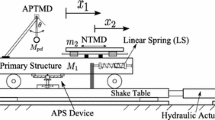Abstract
Presented in this paper is an experimental investigation of a passive auto-tuning mass damper with Pulley connections (PATPD). It is a passive vibration control device that consists of a box filled with silica sand on roller supports. The silica sand provides the mass of the damper. The PATPD is connected to the structure to be controlled by a group of inelastic ropes and pulleys; it is free to move in any translational direction. The pulleys and rope transfer a driving force, resulted from the movement of the structure under control, to the damper. The inertial force from the damper mass, via the connecting rope and pulley, acts on the structure in the direction opposite to any movement and thus providing the vibration control of the structure. Free and forced vibration tests are performed on six MDOF test structures with and without the PATPD as the natural frequencies of the test structures are varied by changing its mass or stiffness whilst keeping the PATPD constant. The test results reveal that the proposed damper, without any tuning or specific adjustment, produces effective control on translational, torsional and coupled vibration of the MDOF structure—even if the vibration frequencies or natural frequencies of the structure that is being controlled changes significantly. The PATPD is simple, effective, robust and adaptive which renders this proposed damper appealing for engineering applications.





















Similar content being viewed by others
References
Hagedorn P, Spelsberg-Korspeter G (2014) Active and passive vibration control of structures. Springer, New York
Chen JL, Georgakis CT (2015) Spherical tuned liquid damper for vibration control in wind turbines. J Vib Control 21(10):1875–1885
Sadhu A, Narasimhan S (2012) Identification of de-tuning level of tuned-mass-damper system using time-series analysis. J Mech Eng Autom 2(1):1–8
Xu Z (2016) Novel active tuned mass damper control method for space telescope. J Guid Control Dyn 39(3):677–684
Jang D, Park J, Jung H (2015) Experimental investigation of an active mass damper system with time delay control algorithm. Smart Struct Syst 15(3):863–879
Zhang C, Ou J (2008) Control strategies and experimental verifications of the electromagnetic mass damper system for structural vibration control. Earthq Eng Eng Vib 17(5):562–594
Zhang C, Ou J (2015) Modeling and dynamical performance of the electromagnetic mass draver system for structural vibration control. Eng Struct 82:93–103
Sun C, Nagarajaiah S, Dick A (2014) Family of smart tuned mass dampers with variable frequency under harmonic excitations and ground motions: closed-form evaluation. Smart Struct Syst 13(2):319–341
Love J, Tait M (2015) Multiple tuned liquid dampers for efficient and robust structural control. J Struct Eng. https://doi.org/10.1061/(ASCE)ST.1943-541X.0001290
Smith MC (2002) Synthesis of mechanical networks: the inerter. IEEE Trans Autom Control 47(10):1648–1662
Brzeski P, Kapitaniak T, Perlikowski P (2015) Novel type of tuned mass damper with inerter which enables changes of inertance. J Sound Vib 349(4):56–66
Dong L, Lakes RS (2012) Advanced damper with negative structural stiffness elements. Smart Mater Struct 21(7):075026 (17pp)
Sarlis AA, Pasala DTR, Constantinou M, Reinhorn A, Nagarajaiah S, Taylor D (2012) Negative stiffness device for seismic protection of structures. J Struct Eng 139:1124–33
Antoniadis IA et al (2015) Hyper-damping properties of a stiff and stable linear oscillator with a negative stiffness. J Sound Vib 346:37–52
Paril O et al (2016) Concept of negative stiffness devices for R.C. buildings in seismic areas. Int J Latest Trends Eng Technol (IJLTET) 7(1):125–132
Chen L, Sun L, Nagarajaiah S (2015) Cable with discrete negative stiffness device and various damper: passive realization and general characteristics. Smart Struct Syst 15(3):627–643
Antoniadis IA et al (2016) KDamping: a stiffness based vibration absorption concept, J Vib Control. https://doi.org/10.1177/1077546316646514
Shi X et al (2015) Magnetic negative stiffness damper. Smart Mater Struct 24:072002
Carlisle M (2013) Experimental investigations into a passive auto-tuning mass damper. MSc Thesis, University of the Witwatersrand, Johannesburg
Zhang C, Li L, Ou J (2010) Swinning motion control of suspended structures: principles and application. Struct Control Health Monit 17(5):549–562
Acknowledgements
The financial assistance of the National Research Foundation (NRF) towards this research is hereby acknowledged. Opinions expressed and conclusions arrived at, are those of the authors and are not necessarily to be attributed to the NRF.
Author information
Authors and Affiliations
Corresponding author
Rights and permissions
About this article
Cite this article
Naicker, E.N., Li, K. Experimental investigation on a passive auto-tuning mass damper for vibration control. Int. J. Dynam. Control 6, 1047–1062 (2018). https://doi.org/10.1007/s40435-017-0381-z
Received:
Revised:
Accepted:
Published:
Issue Date:
DOI: https://doi.org/10.1007/s40435-017-0381-z




